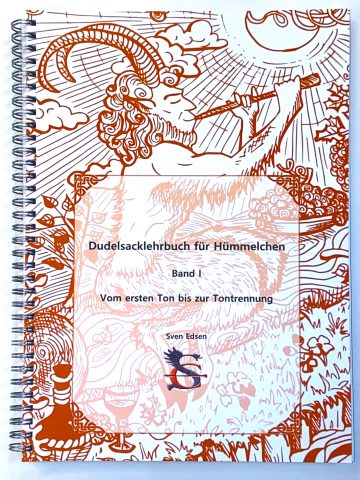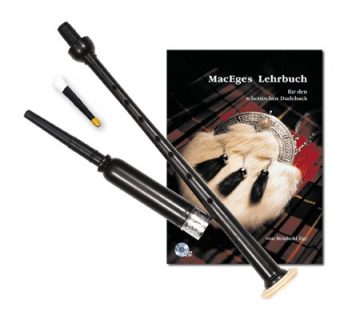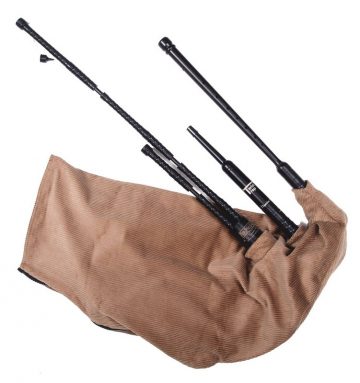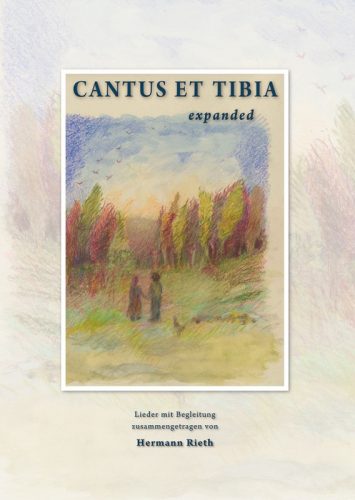Description
CANTUS ET TIBIA, singing and flute playing – this is the motto of the collection of songs by Hermann Rieth, published in three volumes. Here tibia means not only flute but rather wind instrument. The first volume leads from the High Middle Ages to the Renaissance, the second continues to our time. The concluding third volume expands the collection with ten further melodies, set for several voices and arranged by the author.
This collection was created while making music and is specially arranged for the bagpipes Hümmelchen and Dudey in C/F tuning.
In this third volume, the accompaniment parts of the first six titles are printed again separately, so that one does not have to turn the pages so often when playing together. This is followed by three bonus pieces.
Hümmelchen and Dudey are versatile instruments: solo, in a duet or in a quiet ensemble with flutes, violins, harp, cornamuse, gemshorn. The drone carried sound of the small bagpipes has a special charm when accompanying singing. In terms of both timbre and volume, the instrument is a good match for the human voice. The lack of dynamic possibilities of the bagpipe demands a different voice leading from the singer and gives the songs a special character.
Hümmelchen and Dudey, as Michael Praetorius describes them in 1619, are instruments of the late Renaissance and early Baroque. Surely they were played before and for a while after. From today’s perspective, it is interesting to experience how the soft sound of the bagpipes, supported by a powerful drone, fits in with music from times when these instruments were not yet known or were no longer played.
The titles in volume 3:
– Alta Trinita Beata
is a short lauda from the 15th century in Italian colloquial language of anonymous origin, first published by Charles Burney, London 1782.
– It is certainly time
by the poet and theologian Bartholomäus Ringwaldt is a re-poem of the sequence Dies Irae, the Latin Mass for the Dead.
– Laetatus Sum
Based on a two-part canon by A. Gumpelsheimer, an arrangement was created to which two additional movements were added. Laetatus Sum is the beginning of 122. Psalms, a pilgrim song.
– Now Westlin Winds
is an autumn song by Robert Burns, the poet still highly revered in Scotland today. A free translation is attached.
– How lovely is the May
is a sacred spring song of the early baroque. Where two or three in my name is a two-part canon that serves here as the basis for a new arrangement.
– The canon
by Hauptmann has been extended and is further to be played as a canon.
In the second part of this booklet the accompanying parts are reproduced separately so that you don’t have to turn the pages so often.
This is followed by three bonus tracks:
– To newen jar
with the melody of the Mönch von Salzburg and a new accompaniment
– The blue flag
is a dance from northern Germany
– The night horn
in a two-part tune by the monk of Salzburg, to which he gave the subtitle: und ist gut zu blasen.
The arrangements in this booklet are intended to provide inspiration for your own arrangements of further songs or
Play pieces and at the same time give rise to joyful music making.
Hermann Rieth
had recorder lessons with his mother as a child. Later, recorder lessons and playing became an essential compensation during his studies (mathematics and physics for the higher teaching profession) and the training period to become a hand weaver. As a teacher of handicrafts, he continued this passion in making music with students.
With getting to know the Hümmelchen and Dudeys a new intensification began: learning to play the bagpipes, attending courses and making a lot of music. Soon he and a friend began organizing the Schwäbisch Haller Sackpfeifertage. In the process, he developed an interest in early music, the study of old prints and
Manuscripts, and an extensive collection of pieces for Hümmelchen and Dudey was created, which was published by Verlag der Spielleute.
Drones were not notated in early music or later, nor were instrumentations. One can assume that they were a natural part of it and that it was up to the musicians to add continuous tones to a piece. It was also common to sing drone notes. The lineups were probably often based on the available opportunities. In the table of contents, the range of each voice is indicated after the title with quarter notes. The whole note denotes the
Keynote. The casting suggestions can be handled very freely.
Because the editor is a wind player, it comes to the proposals. Other instruments are also very suitable, such as fiddle or violin, harp, lute or guitar, organetto, cornamuse or mandolin, dulcian or bassoon.
The abbreviations for the instrumentations given in the booklet mean: Dud Dudey or Hümmelchen / SG Soprangemshorn / AG Altgemshorn / TG Tenorgemshorn / BG Bassgemshorn / GBG Großbassgemshorn / Bfl Recorder / voc Singstimme. The note “accompaniment” indicates the voices that are included in the 2nd part as a vocal excerpt.
Order no.: 20-1
ISBN: 978-3-943060-20-1
Format: DIN A4
Number of pages: 60 pages
Cover: paperback






Reviews
There are no reviews yet.